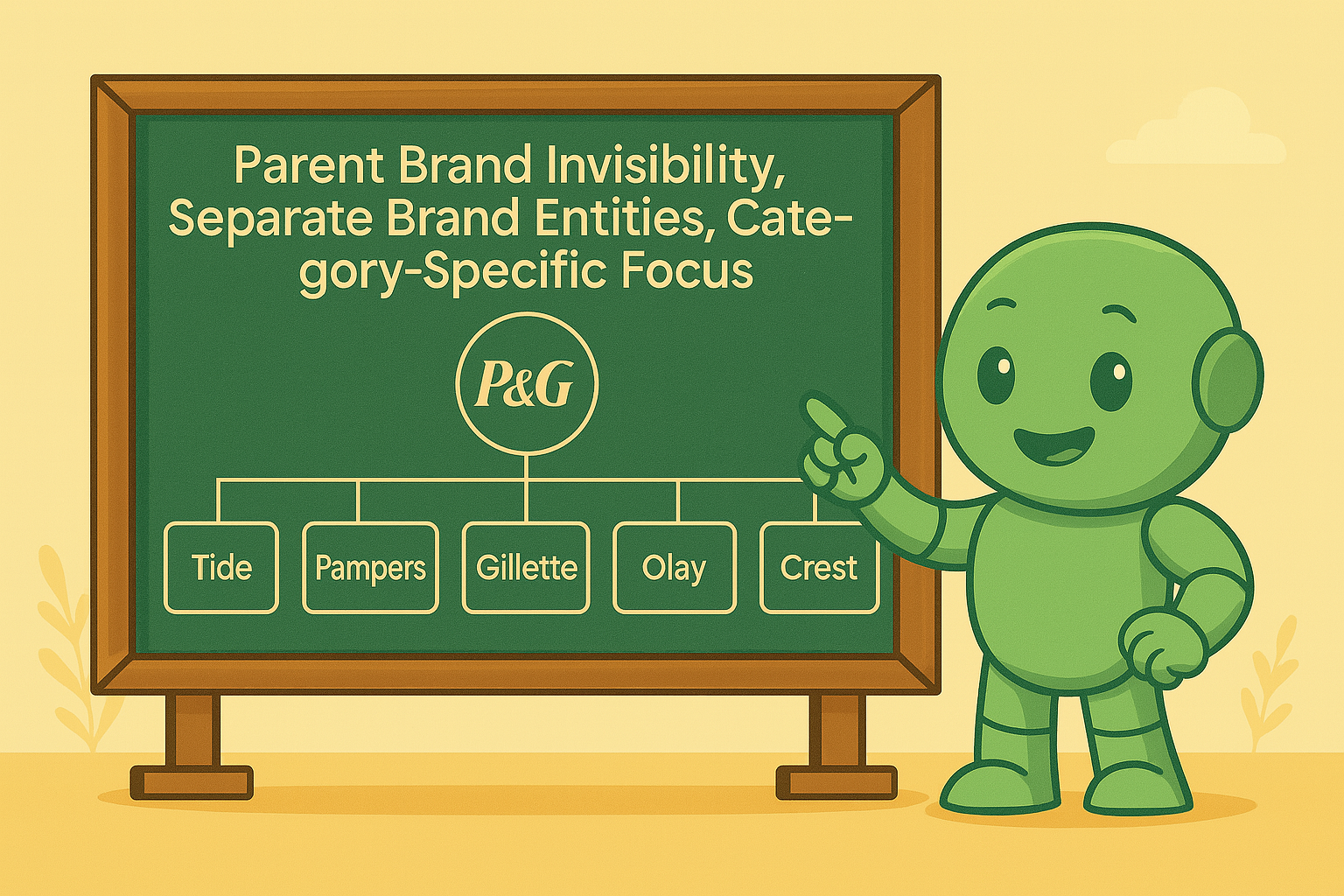8 Brand Hierarchy Examples to Master Your Strategy in 2025
In the complex world of branding, structure is strategy. A well-defined brand hierarchy isn't just an organizational chart; it's a strategic framework that dictates how your products and services relate to each other and to your customers. It guides every decision from marketing spend and naming conventions to market expansion and risk management.
Understanding the different models, from a tightly controlled 'Branded House' to a sprawling 'House of Brands', is crucial for building brand equity, fostering customer loyalty, and achieving sustainable growth. Without a clear architecture, brands risk customer confusion, diluted messaging, and inefficient resource allocation. A powerful brand hierarchy, however, creates clarity and synergy across a portfolio.
This guide moves beyond surface-level descriptions to dissect the most effective brand hierarchy examples from global giants. We will provide a deep strategic analysis of each model, offering actionable insights and replicable tactics. You will learn how companies like Apple, Procter & Gamble, and Marriott structure their portfolios for maximum impact. More importantly, you'll discover how to apply these proven blueprints to your own brand strategy, whether you are managing a single product or a diverse corporate portfolio.
1. Procter & Gamble (P&G) - House of Brands
Procter & Gamble pioneered and perfected the "House of Brands" architecture, a strategy where a parent company owns a portfolio of distinct, individual product brands. This is one of the most powerful brand hierarchy examples because the corporate parent, P&G, remains almost entirely invisible to the average consumer. Each brand, from Tide to Pampers, is managed as a separate business entity with its own unique identity, target audience, and marketing strategy.
The core principle is to allow each brand to dominate its specific market segment without being constrained or diluted by the parent company's identity. This structure enables P&G to capture a wider market share by offering multiple products in the same category that may even compete against each other, such as with their various laundry detergents.
Strategic Analysis: The Power of Invisibility
P&G's model thrives on creating focused, powerful brand equity for each product line. The parent brand's primary role is operational, providing resources, research and development, and supply chain efficiencies behind the scenes.
Key Insight: The House of Brands model insulates individual brands from one another. If one brand faces a public relations crisis, the negative sentiment is contained and does not tarnish the reputation of the parent company or other brands in the portfolio.
This separation allows for hyper-targeted marketing and positioning. Gillette is masculine and performance-driven, while Olay is focused on scientific skincare for women. These distinct identities could not coexist effectively under a single, monolithic corporate brand.
Visualizing the P&G Hierarchy
The following diagram illustrates P&G's House of Brands structure, showing how the parent brand has low visibility while individual product brands maintain strong, independent identities.

This visualization highlights the strategic separation that allows each brand, like Crest or Tide, to build its own dedicated consumer base without being tied to the corporate P&G name.
Actionable Takeaways
- Isolate Brand Risk: Adopt this model to protect your broader portfolio. A challenge for one brand will not automatically become a crisis for all.
- Target Niche Markets: Use standalone brands to connect with highly specific consumer segments, crafting unique value propositions for each.
- Empower Brand Teams: Create dedicated management teams for each brand to foster ownership, expertise, and agile decision-making. These teams can develop a deeper understanding of their market, a key element for anyone looking to build powerful brands and naming conventions.
2. Apple - Branded House
Apple represents the quintessential "Branded House" architecture, a model where a single, powerful master brand serves as the primary identity for all products and services. This is one of the most compelling brand hierarchy examples because every product, from the iPhone to the MacBook, prominently features the Apple name and logo, leveraging the parent brand's enormous equity. This strategy creates a unified, interconnected ecosystem where each product reinforces the value of the others.
The core principle is to build and maintain a monolithic brand that stands for a consistent set of values: innovation, premium quality, and elegant design. Instead of creating separate identities, Apple extends its master brand across diverse categories, ensuring that the consumer's positive experience with one product, like an iPad, translates directly to their perception of another, like the Apple Watch.
Strategic Analysis: The Power of a Unified Ecosystem
Apple's model thrives on creating a seamless and consistent brand experience. The master brand is the star, and every product and service is a supporting character designed to strengthen the overall narrative. This creates immense brand loyalty and a powerful "halo effect" where the success of one product line lifts the entire portfolio.
Key Insight: The Branded House model maximizes marketing efficiency. Every dollar spent promoting the Apple brand benefits all products simultaneously, creating a compounding return on investment that standalone brands cannot achieve.
This unified structure allows Apple to launch new products into new categories with a significant head start. When Apple enters a market, it doesn't just launch a device; it introduces a new member of the trusted Apple family, instantly inheriting decades of brand trust and consumer desire.
Visualizing the Apple Hierarchy
The diagram below illustrates Apple's Branded House structure. It shows how the master brand has maximum visibility, with all sub-brands like iPhone and MacBook directly endorsing and being endorsed by the parent Apple brand.
This visualization highlights the strategic synergy that allows each product to borrow credibility from the master brand while contributing its own success back to the parent.
Actionable Takeaways
- Build a Strong Master Brand: Invest heavily in a single, clear brand identity and positioning that can extend across multiple product lines.
- Create an Ecosystem: Design products and services that work together seamlessly, making the whole portfolio more valuable than the sum of its parts.
- Maintain Strict Brand Consistency: Uphold rigorous standards for design, user experience, and messaging across all touchpoints to reinforce the master brand's promise. This is critical for building a brand that consumers trust implicitly.
3. Marriott - Endorsed Brands
Marriott International masterfully employs an "Endorsed Brands" architecture, a strategy where individual sub-brands maintain distinct identities but are clearly validated by the parent brand. This approach is one of the most effective brand hierarchy examples in the service industry, as it allows for precise market segmentation while leveraging the powerful equity and trust associated with the Marriott name. Brands like The Ritz-Carlton serve the luxury segment, while Courtyard by Marriott targets business travelers, each benefiting from the parent's stamp of quality.
The core principle is to provide consumers with both choice and confidence. A traveler can select a hotel tailored to their specific needs, budget, and desired experience-from the extended-stay Residence Inn to the economy-focused Fairfield Inn-all while being assured of a consistent standard of quality guaranteed by the Marriott endorsement. This structure allows Marriott to compete across multiple price points without diluting its core brand identity.
Strategic Analysis: The Balance of Independence and Trust
Marriott's model hinges on a delicate balance. Each hotel brand has enough autonomy to cultivate its own unique atmosphere, service style, and customer base. The parent brand's endorsement acts as a quality seal, reducing the perceived risk for consumers trying a new sub-brand for the first time.
Key Insight: The Endorsed Brands model accelerates the growth and acceptance of new or acquired brands. By adding "by Marriott" to a name, the company instantly transfers decades of built-up trust and recognition, a feat that would otherwise take years and significant marketing investment to achieve.
This symbiotic relationship is a key driver of the Marriott Bonvoy loyalty program's success. Customers can earn and redeem points across a vast portfolio of distinct hotel experiences, which encourages brand loyalty not just to one hotel type, but to the entire Marriott ecosystem.
Actionable Takeaways
- Leverage Parent Equity: Use a well-known parent brand to endorse new or niche sub-brands, giving them instant credibility and market access.
- Define Sub-Brand Roles: Clearly articulate the target audience, price point, and value proposition for each sub-brand to avoid market confusion and internal competition.
- Integrate Loyalty Systems: Create a unified loyalty program, like Marriott Bonvoy, to encourage customers to explore different brands within your portfolio, increasing lifetime value.
- Maintain Quality Standards: The endorser's reputation is on the line with every sub-brand. Uphold rigorous quality control to ensure the parent brand's promise is consistently delivered.
4. Unilever - Hybrid Architecture
Unilever employs a sophisticated hybrid model, blending the "House of Brands" and "Endorsed Brands" strategies. This approach provides exceptional flexibility, allowing the corporate parent to decide which brands stand alone and which benefit from the Unilever name. This adaptable structure is one of the most dynamic brand hierarchy examples, as it tailors its approach based on a brand's heritage, market position, and strategic goals.
Brands like Dove, Ben & Jerry's, and Hellmann's operate with high autonomy, having built significant equity on their own. Others, particularly in certain regions or product categories, might feature the Unilever logo as a mark of quality and trust. This allows Unilever to acquire strong, independent brands without forcing them into a rigid corporate structure, while also using its parent brand to support others.
Strategic Analysis: The Power of Flexibility
Unilever's hybrid architecture is a masterclass in strategic adaptability. The decision to endorse a brand or let it stand alone is not arbitrary; it is based on deep market analysis and brand equity assessment. This allows the company to optimize its portfolio for both global scale and local relevance.
Key Insight: A hybrid model allows a company to leverage established brand equity from acquired companies while using the corporate brand to build trust for newer or developing brands. This balances preservation with growth.
This flexibility is crucial. For instance, Ben & Jerry's retains its quirky, activist identity, which would clash with a strong corporate endorsement. Meanwhile, a brand like Knorr might use the Unilever endorsement in a new market to accelerate consumer trust, demonstrating a pragmatic, case-by-case approach to brand management.
Actionable Takeaways
- Assess Brand Equity Individually: Don't apply a one-size-fits-all model. Evaluate each brand's existing strength and decide if a corporate endorsement would add value or create brand dissonance.
- Adapt to Local Markets: Use the parent brand endorsement strategically in regions where it carries significant weight, but allow brands to lead in markets where they are already dominant.
- Conduct Regular Portfolio Reviews: The hybrid model's strength is its dynamism. Continuously review your portfolio to determine if a brand's relationship with the parent company should be adjusted to meet evolving market conditions.
5. Google (Alphabet) - Master Brand with Independent Ventures
Google, under its parent company Alphabet, exemplifies a hybrid model that combines a strong master brand for its core digital products with the flexibility of a "house of brands" for its more experimental and unrelated ventures. This is one of the most dynamic brand hierarchy examples because it balances brand equity leverage with strategic insulation. For most users, "Google" is the master brand for products like Search, Maps, and Gmail, creating a unified and trusted ecosystem.
The creation of Alphabet Inc. in 2015 was a strategic move to formalize this separation. It allows the core Google business to maintain its powerful, focused identity while giving "other bets" like Waymo (autonomous driving) and Verily (life sciences) the freedom to develop their own distinct brands. This structure protects the valuable Google brand from the risks associated with these ambitious, long-term projects.
Strategic Analysis: The Power of Strategic Separation
Alphabet's model provides the best of both worlds: brand coherence and innovative freedom. The Google brand lends its immense credibility and user base to its core suite of products, creating a seamless user experience. Meanwhile, Alphabet acts as a holding company, providing capital and resources to its independent ventures without forcing them under the Google umbrella.
Key Insight: This hybrid structure enables Alphabet to pursue high-risk, high-reward "moonshot" projects. If a venture like Waymo were to fail, the negative impact would be contained to that specific brand, leaving the reputation and financial stability of the core Google brand untouched.
This allows for clarity and purpose. Waymo can build a brand around safety and futuristic transportation, while Verily can establish credibility in the highly regulated life sciences industry. These identities would be diluted or confusing if they were simply branded as "Google Cars" or "Google Health."
Actionable Takeaways
- Protect the Core Brand: Use a holding company structure like Alphabet to insulate your primary revenue-generating brand from newer, riskier business ventures.
- Leverage Brand Equity Selectively: Apply your master brand to closely related products to benefit from established trust, but create new brands for ventures in fundamentally different markets.
- Enable Independent Growth: Grant standalone ventures the autonomy to build their own unique brand identities, cultures, and market strategies, which is crucial for attracting specialized talent and partners. A strong foundation in professional naming is essential for these new entities to succeed.
6. The Coca-Cola Company - Umbrella Brand Strategy
The Coca-Cola Company is a primary architect of the "Umbrella Brand" strategy, also known as a branded house model. This approach leverages the immense power and recognition of a single master brand, Coca-Cola, across a family of related products. This strategy stands as one of the most recognized brand hierarchy examples, where sub-brands like Diet Coke and Coca-Cola Zero Sugar directly benefit from the parent's reputation, trust, and marketing muscle.
The core principle is to extend the master brand's equity into new variants and categories, creating a cohesive brand experience. Each product is clearly a member of the Coca-Cola family, which simplifies consumer choice and accelerates market adoption for new launches. The master brand acts as a seal of quality and familiarity, giving each sub-brand an immediate competitive advantage.
Strategic Analysis: The Power of Association
Coca-Cola's model thrives on transferring its core values of happiness, refreshment, and togetherness to its sub-brands. The parent brand is not just a behind-the-scenes operator; it is the main event, providing the foundational identity and marketing platform for the entire portfolio. This creates a powerful, unified market presence.
Key Insight: The Umbrella Brand model streamlines marketing efforts and maximizes the return on brand-building investments. A campaign for the master brand, Coca-Cola, indirectly elevates all the products under its umbrella, creating a halo effect that boosts the entire portfolio.
This unified approach allows for efficient innovation. When Coca-Cola enters a new segment, like energy drinks with Coca-Cola Energy, it uses the established brand name to signal its core attributes while the descriptor "Energy" clarifies the product's specific function. This makes it easier for loyal consumers to try new offerings.
Actionable Takeaways
- Leverage Master Brand Equity: If you have a strong, trusted master brand, use an umbrella strategy to launch new products or variants. This provides instant credibility and reduces the marketing costs associated with building a new brand from scratch.
- Ensure Product Cohesion: Maintain consistent brand values and quality across all extensions. A poor experience with one product can damage the perception of the entire brand family.
- Use Clear Descriptors: Differentiate sub-brands with clear, descriptive names (e.g., "Diet," "Zero Sugar," "Energy") to help consumers navigate your offerings and choose the product that best meets their needs. This is a critical practice for building strong brand architecture.
7. Nestlé - Hybrid Portfolio Architecture
Nestlé employs a complex and highly effective hybrid portfolio architecture, a sophisticated strategy that blends different brand hierarchy models to suit diverse market conditions and product categories. Unlike companies committed to a single structure, Nestlé pragmatically uses house of brands, endorsed brands, and master brand strategies simultaneously. This flexible approach is one of the most dynamic brand hierarchy examples, demonstrating how a global giant adapts its branding to maximize resonance and market penetration.
The core principle is strategic adaptation. For some products like Nescafé, Nestlé uses a master brand approach, leveraging its global recognition. For others, like the pet care brand Purina, it operates more like a house of brands, allowing the product brand to stand on its own. This allows Nestlé to maintain brand equity where it’s strongest while building new, targeted identities where needed.
Strategic Analysis: The Power of Flexibility
Nestlé’s model is built on pragmatism and market intelligence. The decision to endorse a brand (like "Gerber by Nestlé"), make it a master brand (like "Maggi"), or let it stand alone is based on regional consumer perception, brand acquisition history, and competitive landscape. This prevents the company from forcing a rigid corporate identity onto brands that thrive with their own unique heritage.
Key Insight: A hybrid model allows a corporation to optimize its brand strategy on a case-by-case basis. It can leverage the parent brand’s credibility when beneficial, but also allow acquired brands with strong existing equity to retain their independence and consumer trust.
This strategic flexibility is crucial for a company with a portfolio as vast as Nestlé’s. The branding for a confectionery item like KitKat, which has regional variations, requires a different approach than a globally standardized product like Nescafé coffee. The hybrid model accommodates these differences seamlessly.
Actionable Takeaways
- Audit Your Portfolio: Regularly review your brands to determine the best structure for each. Don't apply a one-size-fits-all model if your products serve different markets or have varying levels of brand equity.
- Adapt to Local Markets: If operating internationally, allow for regional adjustments. A master brand in one country might be more effective as an endorsed brand in another where local trust is paramount.
- Maintain Quality Standards: Regardless of the branding structure, ensure consistent quality across the entire portfolio. This builds implicit trust in the parent company, even when it remains in the background.
8. Disney - Lifestyle Brand Ecosystem
Disney operates a unique lifestyle brand ecosystem, a model where the master brand extends across a vast network of entertainment, experiences, products, and services. This is a masterclass among brand hierarchy examples because the core Disney brand serves as a powerful umbrella, creating deep emotional connections and cross-category synergies. Everything from Disney Parks and Resorts to Disney+ is unified by a consistent promise of magic, storytelling, and family-friendly entertainment.
The fundamental principle is to immerse consumers in the Disney world at every possible touchpoint. A child who watches a Disney movie can then visit a character at a theme park, sleep in a Disney-themed hotel room, and read a story from Disney Publishing. This integrated approach transforms the brand from a media company into a pervasive lifestyle.
Strategic Analysis: The Magic of Integration
Disney's model is built on leveraging its powerful intellectual property (IP) across a synergistic portfolio. The success of a film like Frozen directly fuels merchandise sales, theme park attractions, and streaming content, creating a virtuous cycle of engagement and revenue. The master brand, Disney, acts as the seal of quality and emotional consistency.
Key Insight: The Lifestyle Brand Ecosystem model creates powerful cross-promotional opportunities and insulates the brand by diversifying its presence. A downturn in theme park attendance, for instance, can be offset by a surge in streaming subscriptions, all while reinforcing the same core brand values.
This structure allows Disney to build a lifelong relationship with its audience. Consumers enter the ecosystem as children through films and toys and remain engaged as adults through nostalgic content, family vacations, and even Disney Cruise Line experiences. The entire portfolio works together to reinforce a singular, powerful identity.
Actionable Takeaways
- Leverage Core IP: Identify your strongest intellectual property or brand story and find ways to extend it across different products, services, and experiences.
- Maintain Brand Consistency: Ensure that the core values and emotional promise of your master brand are consistently reflected in every sub-brand and touchpoint. This is essential when creating a cohesive brand identity.
- Create Integrated Experiences: Design your offerings to work together, encouraging customers to move seamlessly between different parts of your brand portfolio.
Brand Hierarchy Strategy Comparison of 8 Leading Companies
| Brand Architecture | Implementation Complexity ? | Resource Requirements ⚡ | Expected Outcomes ? | Ideal Use Cases ? | Key Advantages ⭐ |
|---|---|---|---|---|---|
| Procter & Gamble (House of Brands) | High due to managing multiple independent brands | Significant, with separate marketing budgets and teams | Strong segment-specific targeting, risk isolation | Diverse product categories needing distinct identities | Targeted market segments; risk containment |
| Apple (Branded House) | Moderate, unified brand system simplifies management | Lower marketing costs, focus on unified experience | Cohesive brand equity, strong loyalty | Companies emphasizing brand consistency across products | Strong brand equity leverage; customer loyalty |
| Marriott (Endorsed Brands) | High; requires coordination between master and sub-brands | Considerable marketing investment and quality control | Segmented market reach with master brand trust | Businesses offering tiered services under one parent | Combines market segmentation with brand trust |
| Unilever (Hybrid Architecture) | Very high; combines multiple architecture approaches | High, demanding sophisticated marketing and management | Flexibility in brand approach and market adaptation | Complex portfolios balancing independence and endorsement | Optimal strategy fit per brand; market adaptability |
| Google (Master Brand + Ventures) | High; complex corporate and brand separation | High due to managing core and independent ventures | Brand protection with innovation flexibility | Tech companies balancing core branding and innovation | Brand leverage plus risk mitigation |
| Coca-Cola (Umbrella Brand) | Moderate; master brand extended across categories | Efficient marketing through unified brand strategy | Strong global recognition, consistent brand values | Brands with closely related product lines | Cost-effective marketing; strong consumer trust |
| Nestlé (Portfolio Architecture) | Very high; multi-strategy across many markets | High due to diverse brand management and marketing needs | Broad market coverage with optimized brand strategies | Large conglomerates managing diverse global portfolios | Flexibility and strong performance across segments |
| Disney (Lifestyle Brand Ecosystem) | High complexity; integrated cross-category storytelling | High content creation and IP management costs | Emotional loyalty, cross-category synergies | Entertainment and lifestyle brands with IP assets | Emotional connection; multiple revenue streams |
From Blueprint to Reality: Choosing Your Brand Hierarchy
The journey through these diverse brand hierarchy examples reveals a fundamental truth: structure is strategy. From Procter & Gamble's sprawling House of Brands, designed for market dominance through segmentation, to Apple's monolithic Branded House, which leverages a single, powerful identity, the architecture a company chooses is a direct reflection of its business goals, risk tolerance, and vision for the future.
The models we have analyzed, including Marriott's endorsed system and Google's hybrid Alphabet structure, are not just organizational charts. They are strategic blueprints for market penetration, customer communication, and long-term brand equity. Each structure offers a distinct pathway for managing perception, allocating resources, and scaling operations.
Key Strategic Takeaways
As you move from analyzing these brand hierarchy examples to designing your own, several core principles stand out:
- Clarity Above All: A successful brand architecture provides an internal roadmap for decision-making and an external signal of promise to your customers. Ambiguity leads to market confusion and internal inefficiencies.
- Flexibility for Growth: Your chosen structure must support your future ambitions. A Branded House might be perfect for a focused startup, but will it accommodate future diversification? A House of Brands allows for targeted acquisitions, but can you sustain the marketing investment required?
- Risk Management: Your hierarchy dictates how brand crises are contained. In a House of Brands like P&G, a crisis with one brand (e.g., Tide) rarely impacts another (e.g., Pampers). In a Branded House, a single misstep can tarnish the entire portfolio.
Actionable Next Steps for Building Your Hierarchy
Translating these insights into a tangible structure requires deliberate action. Your primary task is to align your brand architecture with your core business strategy.
- Audit Your Current Portfolio: Map out every product, service, and brand you currently offer. Identify existing relationships, naming conventions, and market positions.
- Define Your Strategic Goals: Are you aiming for focused growth, market diversification, or preparation for acquisitions? Your long-term business goals will be the primary determinant of the optimal structure.
- Evaluate Architectural Models: Revisit the brand hierarchy examples in this article. Which model (Branded House, House of Brands, Endorsed, Hybrid) most closely aligns with your strategic objectives and risk profile?
- Develop a Naming Convention: Once you have a structural direction, create clear, consistent rules for naming new products and services. This is a critical component that brings your architecture to life and makes brand relationships understandable to consumers.
Mastering your brand architecture is not merely an academic exercise; it is one of the most powerful levers for sustainable growth. It provides the framework to build, manage, and scale your brands effectively, ensuring each one contributes to a greater, more valuable whole. The right structure transforms a simple collection of products into a powerful, cohesive brand portfolio that can dominate a market and build lasting customer loyalty.
Ready to bring your brand architecture to life with powerful, strategic names? The naming conventions you choose are critical for clarifying brand relationships. NameRobot's suite of AI-powered tools can help you generate and validate names that perfectly align with your chosen hierarchy, ensuring every brand name is a strategic asset. Find the perfect name for your next product, sub-brand, or venture at NameRobot.















